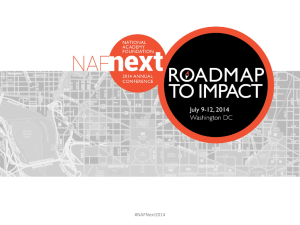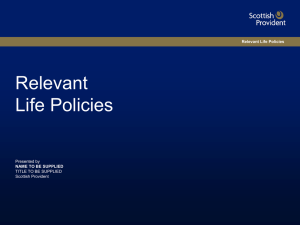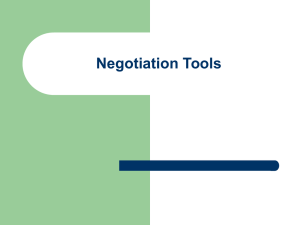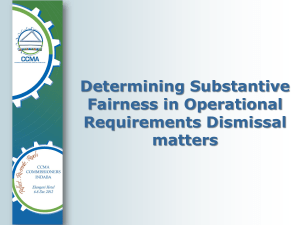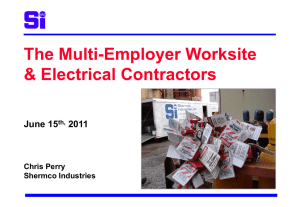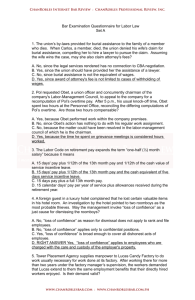Community Based Assessment Leading to Employment
advertisement
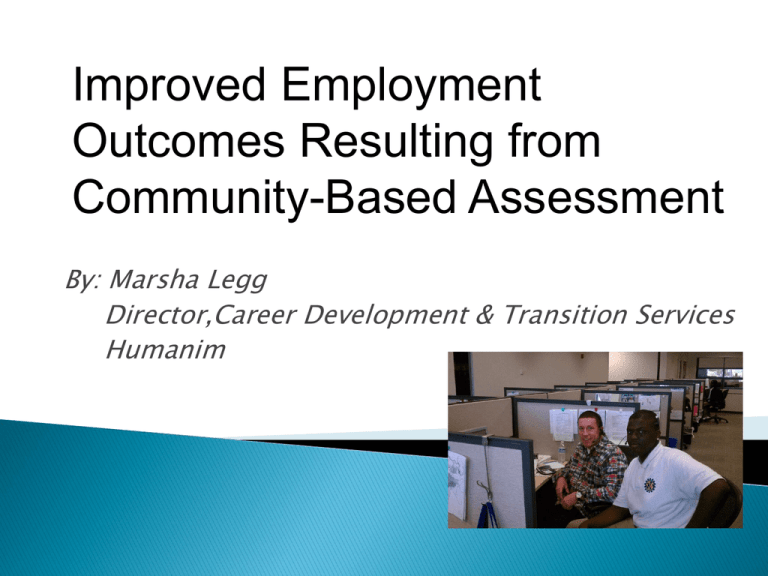
Improved Employment
Outcomes Resulting from
Community-Based Assessment
By: Marsha Legg
Director,Career Development & Transition Services
Humanim
www.edweek.org
2
◦ Far too many drop out of high school (30% or
more)
◦ Youth remain dependent on IEP teams to make
decisions (too few self-determine or advocate)
◦ Youth have few opportunities for communitybased work experiences during school
◦ Youth have difficulty adjusting after exiting high
school
◦ Most are unemployed or underemployed after high
school
◦ Most continue dependence on their families
Thus outcomes from federal and state investments are
unclear or negative—this is why we need assessment
for transition-age youth.
3
Assessment can’t solve all these problems, but
it helps us pay attention!
Assessment can help identify potential
strengths, barriers, accommodations, and
resources.
4
“Transition assessment is an ongoing
process of collecting information on the
student’s strengths, needs, preferences, and
interests as they relate to the demands of
current and future living, learning and
working environments”
All stakeholders participate in the process of
information-gathering and decision-making
2007 Corwin Press. Assess for Success: A Practitioner’s
Handbook on Transition Assessment, 2nd ed., by Stillingtion,
Neubert, Begun, Lombard, and Leconte
5
5
Domains/Content of Transition Assessmen
& Adulthood
Home and Family
Self
Determination
Physical and
Emotional
Health
6
Cronin, M. E. & Patton, J. R. (1993). Life skills instruction for all students with special needs: A practical guide for
integrating real-life content into the curriculum. p 13. Austin TX: PRO-ED.
6
Coordinated Transition Services
At no point in the service delivery system is there more
need for seamless coordination between multiple public
agencies than when the student is transitioning out of high
school and into the adult employment and life.
Community-Based Assessment naturally involves and
supports partnerships between schools, DORS, CRPs, and
employers. Fostering these partnerships leads to better
services for transitioning students and provides a
foundation for competitive employment outcomes.
The value that employers see in the youth is the
foundation of these students’ future careers, and the
clearly demonstrates the validity of this model.
Definition:
A holistic assessment of an individual’s interests,
needs, and abilities in a job/worksite setting
located in the community. Community Based
Assessment is an umbrella term depicting a
category of methods, which may include:
- situational assessment
- on-the-job evaluations
- job try-outs/trials
VEWAA/VECAP Glossary
This type of assessment must take place in a
community setting in which the individual is
integrated with peers without disabilities.
Community Based Assessment cannot occur within
a rehabilitation facility or “enclave” setting (loses
validity).
Community based assessment is functional
assessment
Involves interaction between behavior and
environmental conditions and demands
Determines the impact of disability
Ultimate measurement in natural environment
Personal involvement is critical to selfunderstanding, investment and success
Use Input from client/youth, DORS, SchoolBased Personnel, and Family
- WHAT ARE MAIN INTERESTS – DESIRES FOR EMPLOYMENT –
RECOMMENDATIONS FROM PREVIOUS ASSESSMENTS ?
- WHAT TYPE OF ENVIRONMENT WOULD FIT WELL WITH THIS
CLIENT? WHAT MATCHES THEIR TESTED LEARNING STYLE
AND STATED WORKER PREFERENCES?
TYPES OF CONTACTS:
◦ Warm Contacts!
◦ Cold Walk-Ins
◦ Cold Calls
Don’t forget to do your homework on the employer!!!
GOOD SITES TO CONSIDER
◦ Large establishments which have multiple types of jobs
(allows site to be used for variety of job tasks & for
future assessments)
◦ Employers who pride themselves in community
outreach, service projects, and positive public relations
◦ Non-profits and other organizations who typically host
volunteers
Compliment the employer on the company’s
values, great reputation, friendly atmosphere
◦ Why did you choose them over their competition?
Explain the valuable impact that they can have
on youth being assessed
Differentiate between “assessment” and “job”
Be sure to use references (if you have conducted
an assessment in a similar type of business, tell
them how much the employer enjoyed it…)
Ask for a Job Description
Ask to conduct a Job Analysis (when convenient
for them, not you)
Don’t ask, don’t tell
◦ Don’t raise this topic unless the employer does!
Provide employer with a basic fact sheet about
CBA
◦
◦
◦
◦
Include Purpose
Employer Expectations
Agency Responsibilities
Statement explaining that the arrangement is “not an
employer/employee relationship” and that
employment is not a requested outcome
If the employer brings up liability, be prepared:
(1) Quote Department of Labor Standards
(2) state that “In compliance with IRS Revenue Ruling 65-165
and with standard insurance practice, the Employer-Employee
relationship actually exists between {CRP} and the client who is
participating in a Community Based Assessment experience with
the following understanding:
- The services are for therapeutic or rehabilitative purposes
- The CRP retains final control over the client and this control is
protective
- The client is a registered client of your CRP, and is voluntarily
participating in the assessment
- A CRP staff person will be available to client and employer as needed
Schedule approximately 2-3 days on the job site, 3-6
hours per day (depends on what is appropriate for the
client and acceptable to the employer)
Set up the assessment in order to sample a variety of
duties within a specific position & at various times (i.e.,
busy times and slower times)
Arrange for time to receive some supervisor and
coworker feedback during the assessment
Balancing Act – be un-intrusive, yet gather as much
data as possible!
OBSERVATION… OBSERVATION… OBSERVATION!!!
Observe client & take as many notes as possible
Observe & document environment, job, and task design
Pinpoint strengths, difficulties, coping strategies, etc.
Observe & document interactions with others
(supervisor , coworkers, and customers are equally
important)
Obtain feedback from supervisor and coworker(s)
Complete any necessary forms/paperwork with
employer while there (avoid the burden of having to
schedule yet another visit)
Personally thank everyone involved at work site
Have the client thank everyone involved (this goes a
LONG way!)
Be sure to leave the area as you found it
Have a dialogue with the client about how they liked the
assessment (get specific likes, dislikes, “easy” vs “hard”)
Provide the client with some preliminary feedback about
their performance (try to focus on positive)
Send a follow-up thank you to the employer (card, letter,
email, etc.)
◦ Praise a specific coworker or manager involved. Without
disclosing confidential information, comment on how this
assessment has helped the life of the client/youth.
Maintain this employer relationship!
◦ Do NOT wait until the next time you want/need to use them for
an assessment to make contact. Send them a useful article about
something they mentioned having an interest in; send them a
congratulatory card/email if their company does something
newsworthy; think of ways that you may be able to assist them
(hint – this could be by referring a qualified individual for future
job openings…. Hmmm….
Developed by OVR and Pittsburgh Public
Schools in partnership with the University of
Pittsburgh, Department of Rehabilitation
Science
Specific Training Modules - videos
A Manual
Additional resources and tools
1.
2.
3.
4.
5.
Evaluate the environment independent of the
student (job analysis)
Interview the worksite supervisor independent of
student (CBA Questionnaire)
Interview the student independent of supervisor
(CBA Questionnaire)
Compare interviews scores to determine
discrepancies and workplace issues
When writing the final report, be sure to include
background data and other assessment data
gathered prior to the CBA (i.e., interest inventories,
learning style inventories, work preferences, etc.)
• Based on the Secretary’s
Commission on Achieving
Necessary Skills (SCANS),
Dept. of Labor
• Completed by worksite
supervisors
• Used as a teaching tool to
increase self-awareness
• Shared with IEP Team &
DORS
Community Based Assessment provides valuable
information that cannot necessarily be obtained
through other types of assessment
CBA should be part of an ongoing assessment
process for transitioning youth
CBA can open doors to other employment-related
opportunities
◦ Career Exploration Activities (i.e., job shadowing,
informational interviewing, work-site tours,
volunteering, mentoring
◦ Paid Employment!!
VECAP
Vocational Evaluation and Career Assessment
Professionals
www.vecap.org
VEWAA
Vocational Evaluation and Work Adjustment
Association
www.vewaa.org
26
Career planning begins with assessment: A guide
for professionals serving youth with educational
and career development challenges. (October
2005). Washington, DC: National Collaborative on
Workforce Development for Youth, Institute for
Educational Leadership. www.ncwd-youth.info/
Sitlington, Neubert, Begun, Lombard, & Leconte.
(2nd edition). (in press). Assess for Success: A
practitioner’s guide for transition assessment. CA:
Sage Publications
27
Miller, Lombard, & Corbey. (2007). Transition
Transition Planning Inventory (Clark & Patton)
www.proedinc.com/product
Ansell-Casey Life Skills Assessment/Test
Enderle-Severson Transition Rating Scale
http://www.estr.net/
assessment: Planning transition and IEP
development for youth with mild to moderate
disabilities. Boston, MA: Pearson/Allyn and
Bacon.
http://wareseeker.com/a-ansell-casey-life-skillsassessment/
28
National Association of State Directors of Special
Education, The IDEA Partnership, National
Community of Practice on Transition
(www.ideapartnership.org)
(www.sharedwork.org)
National Center on Secondary Education &
Transition (www.ncset.org)
National Secondary & Transition Technical
Assistance Center (www.nsttac.org)
National Dropout Center for Students with
Disabilities (http://www.ndpc-sd.org/)
National Post-School Outcome Center
(http://www.psocenter.org/)
29
◦ Career Planning Begins with Assessment
(http://www.ncwd-youth.info/a-z)
NSTTAC (www.nsttac.org)
Age Appropriate Transition Assessment Guide
Fact Sheet on Age Appropriate Transition Assessment
Tool Kit for Indicator 13
◦ DCDT Fact Sheet on Transition Specialist
Competencies (www.dcdt.org)
30
30
Marsha L. Legg
Director of Career Development &
Transition Services
Humanim, Inc.
1701 N. Gay Street
Baltimore, MD 21213
mlegg@humanim.com
410-381-7171 (office)
410-563-5188 (fax)
410-736-8428 (cell)



